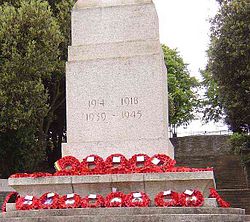The National War Memorial Gardens, Islandbridge
Published in Decade of CentenariesThe erection of a national memorial to servicemen from Ireland who were killed in the Great War was being proposed almost as soon as the war was over; in 1919 a trust fund was established for this purpose. There were various suggestions as to what form a war memorial would take (such as a physical monument, or some form of practical assistance to ex-servicement). Political sensitivities arising from the struggle for independence complicated the issue; Armistice Day events were well attended, but could often serve as flashpoints for trouble, with republicans and Trinity College students being singled out as notable, if diametrically opposing, culprits.
The idea of an actual memorial was ultimately settled on by the early 1920s, though its form and location were still up for debate. Merrion Square was one possible venue, but the prospect of erecting a war memorial there was dismissed by the Free State Minister for Justice, Kevin O’Higgins, who lost a brother in the war yet who went on to point out that a memorial to the dead of the Great War located beside Leinster House could prove misleading: ‘No one denies the sacrifice, and no one denies the patriotic motives which induced the vast majority of those men to join the British Army to take part in the Great War, and yet it is not on their sacrifice that this state is based, and I have no desire to see it suggested that it is’. O’Higgins’ was also wary of its potential exploitation for political purposes: a concern shared by many.
Perhaps inevitably, some disagreed with O’Higgins’ argument, but this may have been a moot point. The trustees of the war memorial project had, by the late 1920s, lost interest in a city centre venue for a memorial, and instead began to focus on the Phoenix Park, which had become the major Dublin venue for the commemoration of Armistice Day. This was partly due to the fact that the police had banned parades on 11 November in the traditional city centre venue of College Green due to their potential for public disorder; but it is also a testament to the sheer scale of Armistice Day events, which could be (and often were) attended by tens of thousands of people. The Phoenix Park was proposed as a possible venue by Sir Bryan Mahon, the former commander of the 10th Division, on the grounds that it could accommodate the large crowds that continued to commemorate Armistice Day until the outbreak of the Second World War.
In December 1929 a site in Islandbridge was chosen. The trustees of the memorial campaign, headed by Sir Andrew Jameson, pledged £54,000 and the government pledged £50,000. In an ecumenical gesture, the labour to build the memorial was to be drawn evenly from veterans of both the British armed forces and the National Army. The memorial itself was designed by Sir Edwin Lutyens, who had been pencilled in to build the abortive gallery that was to have housed Sir Hugh Lane’s art collection, and who had designed was what perhaps the most famous war memorial of all: the cenotaph in London’s Whitehall (a replica of which had been proposed for Dublin in 1919). The memorial he designed for Islandbridge consisted of landscaped gardens, a number of pavilions to house Ireland’s memorial records (as published in the 1920s), along with a ‘stone of remembrance’ and a large celtic cross. It was built between 1931-38, though a planned bridge over the River Liffey linking it to the Phoenix Park was deemed too expensive and was never built. The construction of the memorial gardens straddled the change of government in 1932: Eamon de Valera was supportive of the project and had planned to formally open the memorial in 1939, but this was postponed indefinitely due to the outbreak of the Second World War. The gardens were not officially opened until 1 July 2006: the ninetieth anniversary of the battle of the Somme.
It has been suggested that the somewhat peripheral location of the Irish National War memorial – on what was the western fringe of Dublin, rather then in the city centre – was a deliberate decision that serves as a metaphor for the marginalization of the Great War in Irish public life (a point also made in the 1920s, in fairness). The fact remains, however, that Islandbridge is unique: it remains the largest monument to military service of any description on the island of Ireland.
John Gibney
Further reading:
Keith Jeffery, Ireland and the Great War (Cambridge, 2000).
Nuala Johnson, Ireland, the Great War, and the geography of remembrance (Cambridge, 2003)
To view the official visitors guide to the gardens, click here.

















